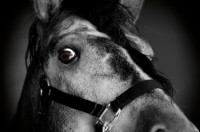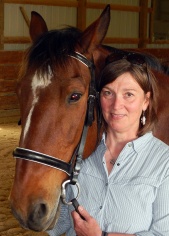Domination, intimidation, confrontation, anthropomorphism – and the effects on your horse.
In this article, we will briefly explore how our ‘frame of mind’, interaction and communication styles affect our horses – mentally and physically!
Watching a young father today with his unruly but content and curious toddler at our local Wholefoods, I remembered a standard sentence that I heard when I was a child: “Why?” “Because I say so.”
The memory triggered number of other phrases that people in my generation will still be familiar with:
- Don’t talk back.
- Children should be seen, not heard.
- ….. the list goes on.
Not blaming the generation of my parents here, who learned their parenting skills from a generation born into monarchy. Not listening was utterly ‘un-Prussian’!
What I am saying in a nut shell: We all know that what we learned to be true at some point, may no longer serve our higher purpose and we can unlearn and relearn to better meet our own and others’ needs – including our horses!
One of those things many riders and horse people need to desperately unlearn and relearn – in my opinion – is the way they interact with horses.
Negative Effects of Confrontational and Threatening Interaction
Ever walked down the street and heard a sudden crash from a car accident? How did your body respond? You went into ‘defense mode‘, preparing to fight or run. Horses and other mammals respond very similarly – with ‘hyperarousal‘. 
Here from loom, S. L. and Farragher, B. (2010) Destroying Sanctuary: The Crisis in Human Service Delivery Systems. New York: Oxford University Press. (pp. 102-106)
“Like other animals [like horses…], humans have formed a highly effective protective system that evolved in our original evolutionary environment when human beings lived in small groups of family members and were threatened by hungry predators. This defensive action system is a total body mobilization, driven by powerful neurochemicals that flood our brain and body. To survive, we must pay attention to any information from the environment that might help us, so many of our senses become more acute—eyes dilate, hearing improves, smells sharpen. Whenever threatened, our attention becomes riveted on the potential threat, and we become hypervigilant to what is going on in our surroundings. … This state is called “hyperarousal” (Horowitz 1986). Below the level of our conscious awareness, we choose appropriate survival-based action: fight, flight, freeze, appease. If we survive the threat, recuperation follows, which is characterized by rest and isolation, wound care, and gradual return to daily activities (van der Hart, Nijenhuis et al. 2005).”
Confrontational Interaction with our horses keeps the horse in a constant state of hyperarousal. This does not always show up as a ‘hot’ horse. The following can be indicators of chronic hyperarousal:
- Shut down and dull, perhaps ‘lazy’
- Shut down and occasionally explosive/unpredictable
- “Rude” – another way of being ‘shut down’ (walks right over you, pushes into you, just wants you to ‘go away’…)
- Aggressive (bites, kicks, aggressive toward other horses)
- Tense (stiff movement, holds breath, grinds teeth, leans on bit or gets behind bit, etc.)
Possible long-term health problems resulting from chronic hyperarousal (examples):
- Arthritic changes (namely in the vertebrae from staying stiff under saddle)
- Ulcers and chronic teeth or TMJ problems
- Stress on muscles, tendons, ligaments and resulting injuries (from lack of suppleness, chronic tension)
- Possibly Insulin Resistance (see source below)
Your frame of mind – and how it plays into your horse’s mental and physical soundness
Our ‘frame of mind’ determines our reality, to a great extent. It provides basically the color glasses we see the world thought. We will then also behave and communicate according to this ‘frame’ and draw respective conclusions.
Example: If I am a surgeon, I will look at every wart as something that can be removed surgically. If I am an herbalist, I will think of a tincture to apply.
When entering the barn – have a ‘horse lovers frame of mind’. And to love the horse means to strive to understand the horse’s nature and actively work to meet its mental, emotional, and physical needs!
“Lasting success can only be achieved, if the heart and soul of all superiors and subordinates [instructors and pupils] is filled with the joy of riding and the love of the horse.” (HDV12 German Cavalry Manual on Training Horse & Rider, Xenophon Press)
Part of our ‘frame of mind’ is composed by things we learned throughout our life, meaning learned behaviors that become – sometimes deeply ingrained – habits. This includes attitudes relating to interaction with others and the respective communication style.
Example: If I have learned that I get ahead at the work place by behaving in an intimidating and dominant manner and that this is the way to get results, I may behave similarly at the parent teacher conference (or at the barn!).
Houston – there is trouble!
Over the years, I have observed many kinds of unhelpful and downright harmful interaction with horses, resulting in behavior and performance problems and unsoundness:
- Confrontational behavior
- Demanding obedience
- Intimidation
- Punishment
- And the greatest sin of all: Anthropomorphism (meaning subscribing human traits, feelings, thought patterns, motives, etc. to your horse)
Number 5 is key here: Perhaps it is possible to be a tough one to deal with at work or at home, if your ‘frame of mind’ at the barn is that of a person, who realized that the nature of the horse demands a completely different set of skills and attitudes, namely:
- Non-confrontational interaction
- Asking for cooperation
- Non-threatening behavior
- Punishment only as immediate response to dangerous behavior (the very rare exception)
- Deep understanding of the nature of the horse as a prey animal that lacks a human’s ability for cunning, strategizing, manipulative, intentionally malicious behavior.
Anthropomorphism (treating your horse as if he/she was a human) sets you up for the following interaction patterns that are not only unfair but also extremely stressful to your horse (examples):
- Untimely and unwarranted ‘reward’ and ‘punishment‘ – often long after the fact, something a horse cannot relate to.
- The habit of assigning human-like motives and strategies to horses. Horses live in the moment. They did not ‘plan’ to do anything more than 3 seconds in advance!
- Expecting your horse to ‘understand’ what you want. (He knows exactly what I want, but doesn’t want to do it.) If your horse understood, he/she would be happy to do it, if you set it up right and strive to understand yourself. Example: Riders, who kick their horse’s sides and shoulders because ‘the horse doesn’t WANT to give me his shoulder’ should be flogged, tarred and feathered. Because that is what that feels like to the horse.
- Constant nagging, tugging, pushing, jerking, yelling, as a response to perceived ‘misbehavior’. This includes making annoying ‘eh, eh, eh’ sounds!
- Treating your horse like a pet and interpreting disrespectful behavior as ‘cute’ or as a sign of ‘intimacy’. Your horse needs to know you will keep him safe. Let him know you are doing that by setting boundaries.
- Being inconsistent and spoiling your horse. You are puzzling your horse! A spoiled horse is a dangerous horse. Create consistency and predictability in every interaction.
- The list goes on…
When looking at your horse – see a horse! Do not transfer the way you understand humans and the behaviors, expectations, interaction and communication styles you may have with humans to your horse!
4 simple steps to improve interaction and relationship with your horse
-
STOP THINKING OR SPEAKING OF YOUR HORSE AS IF HE/SHE WAS A HUMAN!!!
If you have developed this habit, it takes practice to break. For the next week, simply observe how you think and talk about your horse. Does it sound like you are talking about your favorite nephew or some bully in class? Take a deep breath, acknowledge you ‘anthropomorphized’ your horse, and move on. After this first week, you will feel the NEED to change this.
-
ASK – DON’T TELL!
Start by changing your vocabulary around that.
I worked with my horse all morning. NOT I worked my horse all morning.
I am asking for a rein back. NOT I am making him rein back.
Later, you can expand on that by framing every request to your horse in an ‘ask’, not a ‘tell’.
-
DON’T THREATEN YOUR HORSE
You may think you don’t…. But many of us do. Example: I recently stood next to a horse in conversation with the owner, the working student was holding the horse. The working student incessantly jerked on the lead rope/halter every time the horse so much as breathed. It was clear that the expectation: BEHAVE was communicated in a manner that horse must find threatening. This is a hard habit to break as it requires a lot of awareness. My tip: Read the original horse whisperers (Tom Dorrance, Ray Hunt). After that, you may find more wisdom in modern horsemen/women but you will know what to look for.
-
OBSTAIN FROM PUNISHMENT
This is a tough one. The horse was ‘bad’ (anthromorphism) and needs to be punished, isn’t that so? Don’t we hear trainers say – time and again – “Don’t let him get away with it!” or worse “Whack him!”. We don’t want to be bossed by our horse, we don’t want him to get the upper hand and ‘push our buttons’. Right? Wouldn’t this make us look stupid or incapable? No worries… The only worry you should have is how you look in the eyes of your horse. Don’t punish. Redirect, start over, reward.
Exception: My rule is, if a horse shows learned, dangerous misbehavior such as biting humans, I do punish swiftly, clearly, without anger (that’s tough) and without letting this moment linger on. 1 second punishment, the next second we simply move on – on a good note.
IN SHORT
- Horse are horses! Do not interpret horse behavior within the frame of mind applied to human beings, who have completely different needs, behaviors, motives, and agendas.
- Learn non-confrontational interaction with horses!
- Don’t threaten your horse! (Get help in identifying what these threatening behaviors are!)
- Don’t punish your horse! (Redirect, start over, reward. Exception: Learned, dangerous behaviors!)
The reward:
- A better relationship with your horse.
- A more willing horse.
- Better performance.
- Often, improved health and soundness due to a more relaxed body and mind.
Enjoy your horse!

Stefanie Reinhold
www.ReinholdsHorseWellness.com
Sources:
Horse Behavior – A Review of the Human-Horse Relationship
Stress as possible cause of insulin resistance